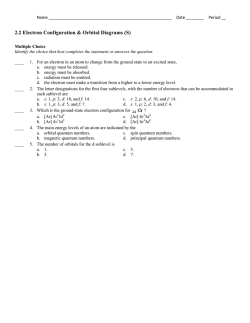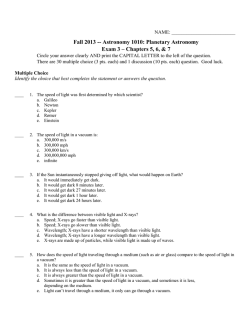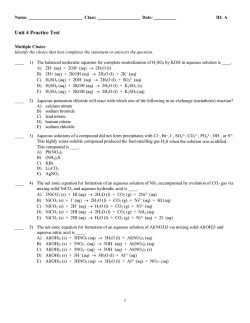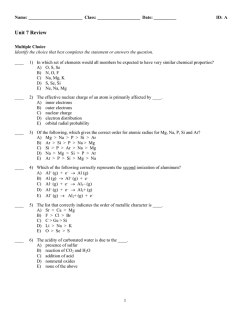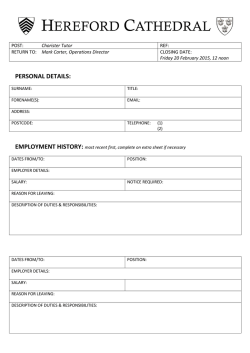
ExamView - ch 7-8 practice test.tst
Name: ________________________ Class: ___________________ Date: __________ ID: A Ch 7-8 Practice test Multiple Choice Identify the choice that best completes the statement or answers the question. ____ ____ ____ ____ ____ ____ ____ 1) The de Broglie wavelength of a ____ will have the shortest wavelength when traveling at 30 cm/s. A) marble B) car C) planet D) uranium atom E) hydrogen atom 2) Which of the subshells below do not exist due to the constraints upon the angular momentum quantum number? A) 2d B) 2s C) 2p D) all of the above E) none of the above 3) An electron cannot have the quantum numbers n = ____, l = ____, m l = ____. A) 6, 1, 0 B) 3, 2, 3 C) 3, 2, –2 D) 1, 0, 0 E) 3, 2, 1 4) Which quantum numbers must be the same for the orbitals that they designate to be degenerate in a one-electron system (such as hydrogen)? A) n, l, and ml B) n and l only C) l and ml D) ml only E) n only 5) In a px orbital, the subscript x denotes the ____. A) energy of the electron B) spin of the electrons C) probability of the shell D) size of the orbital E) axis along which the orbital is aligned 6) Which of the following is not a valid set of four quantum numbers? (n, l, ml, ms) A) 2, 0, 0, +1/2 B) 2, 1, 0, –1/2 C) 3, 1, –1, –1/2 D) 1, 0, 0, +1/2 E) 1, 1, 0, +1/2 7) Which of the following is a valid set of four quantum numbers? (n, l, m l, ms) A) 2, 1, 0, +1/2 B) 2, 2, 1, –1/2 C) 1, 0, 1, +1/2 D) 2, 1, +2, +1/2 E) 1, 1, 0, –1/2 1 Name: ________________________ ____ ID: A 8) Which electron configuration represents a violation of the Pauli exclusion principle? A) B) C) D) E) ____ 9) Which one of the following configurations depicts an excited oxygen atom? A) 1s22s22p2 B) 1s22s22p23s2 C) 1s22s22p1 D) 1s22s22p4 E) [He]2s22p4 ____ 10) Which one of the following configurations depicts an excited carbon atom? A) 1s22s22p13s1 B) 1s22s22p3 C) 1s22s22p1 D) 1s22s23s1 E) 1s22s22p2 2 Name: ________________________ ID: A ____ 11) Which electron configuration represents a violation of Hund's rule for an atom in its ground state? A) B) C) D) E) ____ 12) Which electron configuration represents a violation of Hund's rule for an atom in its ground state? A) B) C) D) E) ____ 13) Which of the following elements has a ground-state electron configuration different from the predicted one? A) Cu B) Ca C) Xe D) Cl E) Ti 3 Name: ________________________ ID: A ____ 14) The valence shell of the element X contains 2 electrons in a 5s subshell. Below that shell, element X has a partially filled 4d subshell. What type of element is X? A) main group element B) chalcogen C) halogen D) transition metal E) alkali metal ____ 15) An FM radio station broadcasts electromagnetic radiation at a frequency of 89.7 MHz. The wavelength of this radiation is ________ m. A) 3.34 106 B) 3.34 C) 2.69 1016 D) 2.69 1010 E) 0.299 ____ 16) Electromagnetic radiation with a wavelength of 425 nm appears as violet light to the human eye. The energy of one photon of this light is ________ J. A) 8.45 10–32 B) 4.68 10–28 C) 4.68 10–19 D) 8.45 10–23 E) 2.14 1018 ____ 17) Electromagnetic radiation with a wavelength of 641 nm appears as orange light to the human eye. The energy of one photon of this light is 3.10 10–19 J. Thus, a laser that emits 1.3 10–2 J of energy in a pulse of light at this wavelength produces ________ photons in each pulse. A) 2.4 10–17 B) 6.3 10–24 C) 2.7 1019 D) 4.2 1016 E) 6.5 1013 ____ 18) A radio station broadcasts at 99.5 MHz. The wavelength of the signal is ________ m. A) 3.10 B) 3.02 C) 2.90 D) 2.75 E) 4.71 ____ 19) When the electron in a hydrogen atom moves from n = 5 to n = 2, light with a wavelength of ________ nm is emitted. A) 93.8 B) 410 C) 487 D) 657 E) 434 ____ 20) The symbol for the spin magnetic quantum number is ________. A) ms B) n C) l D) ml E) sm 4 Name: ________________________ ID: A ____ 21) At maximum, an d-subshell can hold ________ electrons. A) 10 B) 6 C) 2 D) 8 E) 14 ____ 22) If an electron has a principal quantum number (n) of 7 and an angular momentum quantum number (l) of 3, the subshell designation is ________. A) 7f B) 7s C) 7p D) 3f E) 3d ____ 23) Which one of the following represents an acceptable set of quantum numbers for an electron in an atom? (arranged as n, l, ml, and ms ) A) 3, 2, –2, –1/2 B) 3, 3, –4, 1/2 C) 3, 4, 6, –1/2 D) 3, 2, 0, 0 E) 3, 3, 3, –1/2 ____ 24) The ground-state electron configuration of V is ________. A) 1s22s22p63s23p64s23d3 B) 1s22s22p63s23p63d5 C) 1s22s22p63s23p11 D) 1s22s22p63s23p64s23d4 E) None of the above ____ 25) The complete electron configuration of sulfur, element 16, is ________. A) 1s22s22p63s23p4 B) 1s22s22p103s2 C) 1s42s42p63s2 D) 1s42s42p8 E) 1s62s62p23s2 ____ 26) In a ground-state copper atom, the ________ subshell is partially filled. A) 3s B) 4s C) 4p D) 3d E) 4d ____ 27) Atomic radius generally decreases as we move ____. A) down a group and from right to left across a period B) up a group and from left to right across a period C) down a group and from left to right across a period D) up a group and from right to left across a period E) down a group; the period position has no effect 5 Name: ________________________ ID: A ____ 28) Of the following, which gives the correct order for atomic radius for Ca, K, As, Ge and Kr? A) Ca > K > As > Ge > Kr B) Kr > Ge > As > K > Ca C) Ge > As > Kr > K > Ca D) K > Ca > Ge > As > Kr E) Kr > As > Ge > Ca > K ____ 29) Of the compounds below, ____ has the smallest ionic separation. A) KF B) K2S C) RbCl D) SrBr2 E) RbF ____ 30) Which of the following is an isoelectronic series? A) B5–, Si4–, As3–, Te2– B) F–, Cl–, Br–, I– C) S, Cl, Ar, K D) Si2–, P2–, S2–, Cl2– E) O2–, F–, Ne, Na+ ____ 31) Of the choices below, which gives the order for first ionization energies? A) Kr > Se > Br > Ga > Ge B) Kr > Br > Se > Ge > Ga C) Ga > Br > Ge > Kr > Se D) Ga > Ge > Se > Br > Kr E) Br > Se > Ga > Kr > Ge ____ 32) Which of the following correctly represents the third ionization of aluminum? A) Al2+ (g) + e– Al+ (g) B) Al (g) Al+ (g) + e– C) Al2– (g) + e– Al3– (g) D) Al2+ (g) + e– Al3+ (g) E) Al2+ (g) Al3+ (g) + e– ____ 33) Which of the following correctly represents the second ionization of calcium? A) Ca (g) Ca+ (g) + e– B) Ca+ (g) Ca2+ (g) + e– C) Ca– (g) + e– Ca2– (g) D) Ca+ (g) + e– Ca2+ (g) E) Ca+ (g) + e– Ca (g) ____ 34) The electron configuration that belongs to the atom with the lowest second ionization energy is ____. A) (i) B) (ii) C) (iii) D) (iv) E) (v) ____ 35) The electron configuration of the atom with the most negative electron affinity is ____. A) (i) B) (ii) C) (iii) D) (iv) E) (v) 6 Name: ________________________ ID: A ____ 36) Of the following elements, ____ has the most negative electron affinity. A) O B) K C) B D) Na E) S ____ 37) Which of the following correctly represents the electron affinity of phosphorus? A) P (g) P+ (g) + e– B) P (g) + e– P– (g) C) P4 (g) + e– P– (g) D) P4 (g) + 4e– 4P– (g) E) P+ (g) + e– P (g) ____ 38) In the generation of most anions, the energy change (kJ/mol) that ____ an electron is ____. A) removes, positive B) adds, positive C) removes, negative D) adds, negative E) None of the above is correct. ____ 39) Which one of the following compounds would produce an acidic solution when dissolved in water? A) Na2O B) CaO C) MgO D) CO2 E) SrO ____ 40) Between which two elements is the difference in metallic character the greatest? A) Rb and O B) O and I C) Rb and I D) Li and O E) Li and Rb ____ 41) Which of the following traits characterizes the alkali metals? A) very high melting point B) existence as diatomic molecules C) formation of dianions D) the lowest first ionization energies in a period E) the smallest atomic radius in a period ____ 42) This element is more reactive than lithium and magnesium but less reactive than potassium. This element is ____. A) Na B) Rb C) Ca D) Be E) Fr 7 Name: ________________________ ID: A ____ 43) Which of the following generalizations cannot be made with regard to reactions of alkali metals? (The symbol M represents any one of the alkali metals.) A) M (s) + O2 (g) MO2 (s) B) 2M (s) + 2H2O (l) 2MOH (aq) + H2 (g) C) 2M (s) + H2 (g) 2MH (s) D) 2M (s) + Cl2 (g) 2MCl (s) E) 2M (s) + S (s) M2S (s) ____ 44) The reaction of alkali metals with oxygen produce ____. A) oxides B) peroxides C) superoxides D) all of the above E) none of the above ____ 45) Alkali metals tend to be more reactive than alkaline earth metals because ____. A) alkali metals have lower densities B) alkali metals have lower melting points C) alkali metals have greater electron affinities D) alkali metals have lower ionization energies E) Alkali metals are not more reactive than alkaline earth metals. ____ 46) Which alkaline earth metal will not react with liquid water or with steam? A) Be B) Mg C) Ca D) Ba E) They all react with liquid water and with steam. ____ 47) ____ is a unique element and does not truly belong to any family. A) Nitrogen B) Radium C) Hydrogen D) Uranium E) Helium ____ 48) Hydrogen is unique among the elements because ____. 1. It has only one valence electron. 2. It is the only element that can emit an atomic spectrum. 3. Its electron is not at all shielded from its nucleus. 4. It is the lightest element. 5. It is the only element to exist at room temperature as a diatomic gas. A) 1, 2, 3, 4, 5 B) 1, 3, 4 C) 1, 2, 3, 4 D) 2, 3, 4 E) 3, 4 ____ 49) In which orbital does an electron in a copper atom experience the greatest effective nuclear charge? A) 1s B) 4s C) 4p D) 4d E) 3d 8 Name: ________________________ ID: A ____ 50) In which of the following atoms is the 3s orbital closest to the nucleus? A) S B) Po C) Te D) Se E) P ____ 51) ____ is isoelectronic with krypton. A) Se2– B) Se3– C) Br D) Se2+ E) Te2– ____ 52) ____ is isoelectronic with argon, and ____ is isoelectronic with neon. A) P3–, N3– B) P2–, N2– C) P3+, N3+ D) N3–, P3– E) P, N ____ 53) The ion with the smallest diameter is ____. A) Li+ B) Na+ C) K+ D) Rb+ E) Cs+ ____ 54) The ion with the largest diameter is ____. A) Po2– B) S2– C) Se2– D) Te2– E) O2– ____ 55) Of the following atoms, which has the largest first ionization energy? A) K B) Rb C) Sr D) Ca E) Ba ____ 56) Of the following elements, ____ has the most negative electron affinity. A) F B) Cl C) Br D) H E) I ____ 57) Which one of the following is a metalloid? A) Si B) S C) Cl D) In E) Li 9 Name: ________________________ ID: A ____ 58) All of the following are ionic compounds except ____. A) CH4 B) K2O C) Be(OH)2 D) NiCl2 E) Sr3N2 ____ 59) Element M reacts with oxygen to form an oxide with the formula M 2O. When M2O is dissolved in water, the resulting solution is basic. Element M could be ____. A) calcium B) bromine C) oxygen D) carbon E) nitrogen ____ 60) In which set of elements would all members be expected to have very similar chemical properties? A) O, S, Se B) N, O, F C) Na, Mg, K D) S, Se, Si E) Ne, Na, Mg ____ 61) The atomic radius of main-group elements generally increases down a group because ____. A) effective nuclear charge increases down a group B) effective nuclear charge decreases down a group C) effective nuclear charge zigzags down a group D) the principal quantum number of the valence orbitals increases E) both effective nuclear charge increases down a group and the principal quantum number of the valence orbitals increases ____ 62) Which of the following correctly represents the second ionization of copper? A) Cu (g) Cu+ (g) + e– B) Cu+ (g) Cu2+ (g) + e– C) Cu– (g) + e– Cu2– (g) D) Cu+ (g) + e– Cu2+ (g) E) Cu+ (g) + e– Cu (g) ____ 63) Sodium is much more apt to exist as a cation than is chlorine. This is because ____. A) chlorine is a gas and sodium is a solid B) chlorine has a greater electron affinity than sodium does C) chlorine is bigger than sodium D) chlorine has a greater ionization energy than sodium does E) chlorine is more metallic than sodium ____ 64) The list that correctly indicates the order of metallic character is ____. A) Sr > Ca > Mg B) F > Cl > Br C) C > Ge > Si D) Li > Na > K E) O > Se > S 10 Name: ________________________ ID: A ____ 65) Of the following oxides, ____ is the most acidic. A) CaO B) CO2 C) Al2O3 D) Li2O E) Na2O ____ 66) Nonmetals can be ____ at room temperature. A) solid, liquid, or gas B) solid or liquid C) solid only D) liquid only E) liquid or gas ____ 67) Consider the following properties of an element: (i) (ii) (iii) (iv) It is solid at room temperature. It easily forms an oxide when exposed to air. When it reacts with water, hydrogen gas evolves. It must be stored submerged in oil. Which element fits the above description the best? A) sulfur B) copper C) mercury D) sodium E) magnesium ____ 68) ____ is isoelectronic with scandium. A) Cr3+ B) Mn5+ C) Mn D) Mn4– E) K+ ____ 69) Of the elements below, ____ is the least metallic. A) Ne B) F C) Cl D) O E) S True/False Indicate whether the statement is true or false. ____ 1) The wavelength of radio waves can be longer than a football field. ____ 2) Blackbody radiation is the emission of light from metal surfaces. ____ 3) If a hydrogen atom electron jumps from the n=6 orbit to the n=2 orbit, energy is released. ____ 4) The square of Schrodinger's wave equation is called an orbital. ____ 5) The electron density of the 2s orbital is asymmetric. 11 Name: ________________________ ID: A ____ 6) The larger the principal quantum number of an orbital, the lower is the energy of the electrons in that orbital. ____ 7) When the value of n is greater than or equal to 3, electrons can reside in d orbitals. ____ 8) An NMR spectrum results from photon irradiation in which the nuclear spin alignment is flipped. ____ 9) The effective nuclear charge acting on an electron is larger than the actual nuclear charge. ____ 10) The effective nuclear charge in an atom is proportional to the number of nuclear protons. ____ 11) The atomic radius of iodine is one-half the distance separating the iodine nuclei. ____ 12) A group of ions all containing the same number of electrons constitutes an isoelectronic series. ____ 13) Elements that readily conduct electricity are elements with low ionization energies. ____ 14) Electron affinity measures how easily an atom gains an electron. ____ 15) Xenon can form compounds with fluorine. 12 ID: A Ch 7-8 Practice test Answer Section MULTIPLE CHOICE 1) ANS: OBJ: 2) ANS: OBJ: 3) ANS: OBJ: 4) ANS: OBJ: 5) ANS: OBJ: 6) ANS: OBJ: 7) ANS: OBJ: 8) ANS: OBJ: 9) ANS: OBJ: 10) ANS: OBJ: 11) ANS: OBJ: 12) ANS: OBJ: 13) ANS: OBJ: 14) ANS: OBJ: 15) ANS: OBJ: 16) ANS: OBJ: 17) ANS: OBJ: 18) ANS: OBJ: 19) ANS: OBJ: 20) ANS: OBJ: 21) ANS: OBJ: C 6.4; G2 A 6.5; G2 B 6.5; G2 E 6.5; G2 E 6.5; G2 E 6.7; G2 A 6.7; G2 C 6.8; G2 B 6.8; G2 A 6.8; G2 C 6.8; G2 D 6.8; G2 A 6.8; G2 D 6.9; G2 B 6.1; G4 C 6.2; G4 D 6.2; G4 B 6.2; G4 E 6.3; G4 A 6.5; G2 A 6.5; G2 PTS: 1 DIF: 1 REF: Page Ref: 6.4 PTS: 1 DIF: 1 REF: Page Ref: 6.5 PTS: 1 DIF: 2 REF: Page Ref: 6.5 PTS: 1 DIF: 1 REF: Page Ref: 6.6 PTS: 1 DIF: 1 REF: Page Ref: 6.6 PTS: 1 DIF: 2 REF: Page Ref: 6.7 PTS: 1 DIF: 2 REF: Page Ref: 6.7 PTS: 1 DIF: 2 REF: Page Ref: 6.8 PTS: 1 DIF: 2 REF: Page Ref: 6.8 PTS: 1 DIF: 2 REF: Page Ref: 6.8 PTS: 1 DIF: 2 REF: Page Ref: 6.8 PTS: 1 DIF: 2 REF: Page Ref: 6.8 PTS: 1 DIF: 2 REF: Page Ref: 6.8 PTS: 1 DIF: 1 REF: Page Ref: 6.9 PTS: 1 DIF: 1 REF: Page Ref: 6.1 PTS: 1 DIF: 2 REF: Page Ref: 6.2 PTS: 1 DIF: 2 REF: Page Ref: 6.2 PTS: 1 DIF: 2 REF: Page Ref: 6.2 PTS: 1 DIF: 4 REF: Page Ref: 6.3 PTS: 1 DIF: 1 REF: Page Ref: 6.5 PTS: 1 DIF: 2 REF: Page Ref: 6.5 1 ID: A 22) ANS: OBJ: 23) ANS: OBJ: 24) ANS: OBJ: 25) ANS: OBJ: 26) ANS: OBJ: 27) ANS: OBJ: 28) ANS: OBJ: 29) ANS: OBJ: 30) ANS: OBJ: 31) ANS: OBJ: 32) ANS: OBJ: 33) ANS: OBJ: 34) ANS: OBJ: 35) ANS: OBJ: 36) ANS: OBJ: 37) ANS: OBJ: 38) ANS: OBJ: 39) ANS: OBJ: 40) ANS: OBJ: 41) ANS: OBJ: 42) ANS: OBJ: 43) ANS: OBJ: 44) ANS: OBJ: 45) ANS: OBJ: A PTS: 6.5; G2 A PTS: 6.5; G2 A PTS: 6.8; G2 A PTS: 6.5; G2 D PTS: 6.5; G2 B PTS: 7.2, 7.3, 7.4, 7.5; G2 D PTS: 7.2, 7.3, 7.4, 7.5; G2 A PTS: 7.2, 7.3, 7.4, 7.5; G2 E PTS: 7.3; G2 B PTS: 7.2, 7.3, 7.4, 7.5; G2 E PTS: 7.4; G2 B PTS: 7.4; G2 B PTS: 7.2, 7.3, 7.4, 7.5; G2 E PTS: 7.2, 7.3, 7.4, 7.5; G2 E PTS: 7.2, 7.3, 7.4, 7.5; G2 B PTS: 7.5; G2 D PTS: 7.5; G2 D PTS: 7.6; G2 A PTS: 7.6; G2 D PTS: 7.7; G2 A PTS: 7.7; G2 A PTS: 7.7, 7.8; G2 D PTS: 7.7, 7.8; G2 D PTS: 7.7, 7.8; G2 1 DIF: 1 REF: Page Ref: 6.5 1 DIF: 1 REF: Page Ref: 6.5 1 DIF: 1 REF: Page Ref: 6.8 1 DIF: 2 REF: Page Ref: 6.8 1 DIF: 2 REF: Page Ref: 6.8 1 DIF: 1 REF: Page Ref: 7.3 1 DIF: 1 REF: Page Ref: 7.3 1 DIF: 1 REF: Page Ref: 7.3 1 DIF: 1 REF: Page Ref: 7.3 1 DIF: 1 REF: Page Ref: 7.4 1 DIF: 1 REF: Page Ref: 7.4 1 DIF: 1 REF: Page Ref: 7.4 1 DIF: 1 REF: Page Ref: 7.4 1 DIF: 1 REF: Page Ref: 7.5 1 DIF: 1 REF: Page Ref: 7.5 1 DIF: 1 REF: Page Ref: 7.5 1 DIF: 3 REF: Page Ref: 7.5 1 DIF: 1 REF: Page Ref: 7.6 1 DIF: 1 REF: Page Ref: 7.6 1 DIF: 1 REF: Page Ref: 7.7 1 DIF: 1 REF: Page Ref: 7.7 1 DIF: 1 REF: Page Ref: 7.7 1 DIF: 2 REF: Page Ref: 7.7 1 DIF: 1 REF: Page Ref: 7.7 2 ID: A 46) ANS: OBJ: 47) ANS: OBJ: 48) ANS: OBJ: 49) ANS: OBJ: 50) ANS: OBJ: 51) ANS: OBJ: 52) ANS: OBJ: 53) ANS: OBJ: 54) ANS: OBJ: 55) ANS: OBJ: 56) ANS: OBJ: 57) ANS: OBJ: 58) ANS: OBJ: 59) ANS: OBJ: 60) ANS: OBJ: 61) ANS: OBJ: 62) ANS: OBJ: 63) ANS: OBJ: 64) ANS: OBJ: 65) ANS: OBJ: 66) ANS: OBJ: 67) ANS: OBJ: 68) ANS: OBJ: A PTS: 7.7, 7.8; G2 C PTS: 7.7; G2 E PTS: 7.7; G2 A PTS: 7.2; G2 B PTS: 7.2; G2 A PTS: 7.3; G2 A PTS: 7.3; G2 A PTS: 7.2, 7.3, 7.4, 7.5; G2 A PTS: 7.2, 7.3, 7.4, 7.5; G2 D PTS: 7.2, 7.3, 7.4, 7.5; G2 A PTS: 7.5; G2 A PTS: 7.6; G2 A PTS: 7.7, 7.8; G2 A PTS: 7.7, 7.8; G2 A PTS: G2 D PTS: 7.2, 7.3, 7.4, 7.5; G2 B PTS: 7.4; G2 D PTS: 7.5; G2 A PTS: 7.6; G2 B PTS: 7.6; G2 A PTS: 7.6; G2 D PTS: 7.7; G2 A PTS: 7.3; G2 1 DIF: 2 REF: Page Ref: 7.7 1 DIF: 1 REF: Page Ref: 7.8 1 DIF: 2 REF: Page Ref: 7.8 1 DIF: 2 REF: Page Ref: 7.2 1 DIF: 1 REF: Page Ref: 7.2 1 DIF: 1 REF: Page Ref: 7.3 1 DIF: 1 REF: Page Ref: 7.3 1 DIF: 1 REF: Page Ref: 7.4 1 DIF: 1 REF: Page Ref: 7.4 1 DIF: 1 REF: Page Ref: 7.4 1 DIF: 1 REF: Page Ref: 7.5 1 DIF: 1 REF: Page Ref: 7.6 1 DIF: 1 REF: Page Ref: 7.7 1 DIF: 1 REF: Page Ref: 7.7 1 DIF: 1 REF: Page Ref: 7.1 1 DIF: 2 REF: Page Ref: 7.3 1 DIF: 1 REF: Page Ref: 7.4 1 DIF: 1 REF: Page Ref: 7.5 1 DIF: 1 REF: Page Ref: 7.6 1 DIF: 1 REF: Page Ref: 7.6 1 DIF: 1 REF: Page Ref: 7.6 1 DIF: 1 REF: Page Ref: 7.7 1 DIF: 1 REF: Page Ref: 7.3 3 ID: A 69) ANS: A OBJ: 7.6; G2 PTS: 1 DIF: 1 REF: Page Ref: 7.6 PTS: 1 DIF: 1 REF: Page Ref: 6.1 PTS: 1 DIF: 1 REF: Page Ref: 6.2 PTS: 1 DIF: 1 REF: Page Ref: 6.3 PTS: 1 DIF: 1 REF: Page Ref: 6.4 PTS: 1 DIF: 1 REF: Page Ref: 6.5 PTS: 1 DIF: 2 REF: Page Ref: 6.7 PTS: 1 DIF: 2 REF: Page Ref: 6.7 PTS: 1 DIF: 3 REF: Page Ref: 6.8 PTS: 1 DIF: 1 REF: Page Ref: 7.2 PTS: 1 DIF: 3 REF: Page Ref: 7.2 PTS: 1 DIF: 1 REF: Page Ref: 7.3 PTS: 1 DIF: 1 REF: Page Ref: 7.3 PTS: 1 DIF: 2 REF: Page Ref: 7.4 PTS: 1 DIF: 2 REF: Page Ref: 7.5 PTS: 1 DIF: 1 REF: Page Ref: 7.8 TRUE/FALSE 1) ANS: OBJ: 2) ANS: OBJ: 3) ANS: OBJ: 4) ANS: OBJ: 5) ANS: OBJ: 6) ANS: OBJ: 7) ANS: OBJ: 8) ANS: OBJ: 9) ANS: OBJ: 10) ANS: OBJ: 11) ANS: OBJ: 12) ANS: OBJ: 13) ANS: OBJ: 14) ANS: OBJ: 15) ANS: OBJ: T 6.1; G2 F 6.2; G2 T 6.3; G2 T 6.4; G2 F 6.5; G2 F 6.7; G2 T 6.7; G2 T 6.8; G2 F 7.2; G2 F 7.2; G2 T 7.3; G2 T 7.3; G2 T 7.4; G2 T 7.5; G2 T 7.8; G2 4
© Copyright 2025
